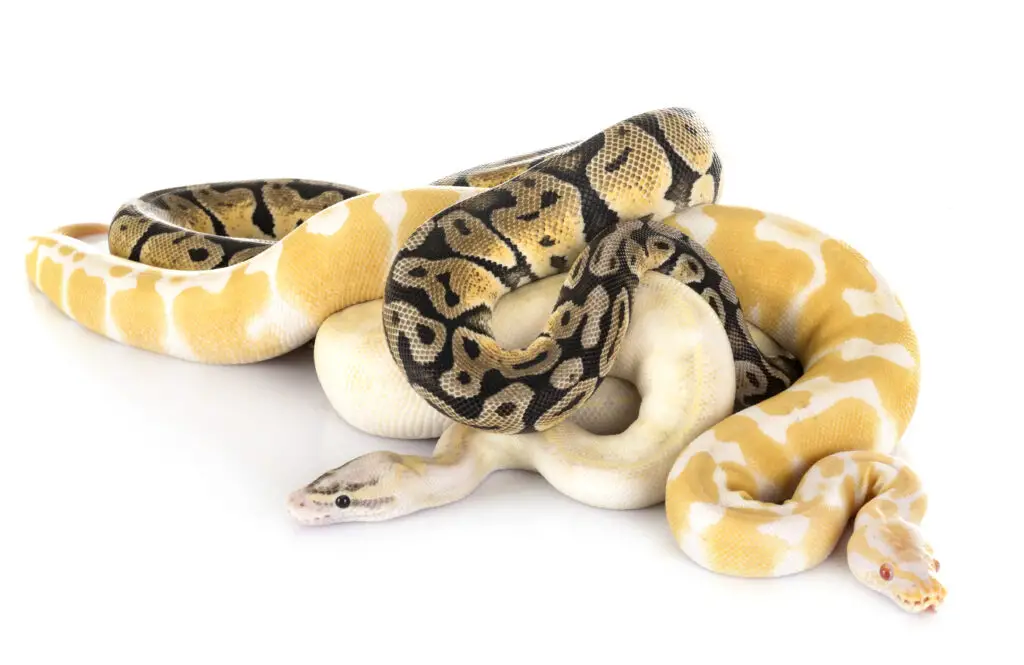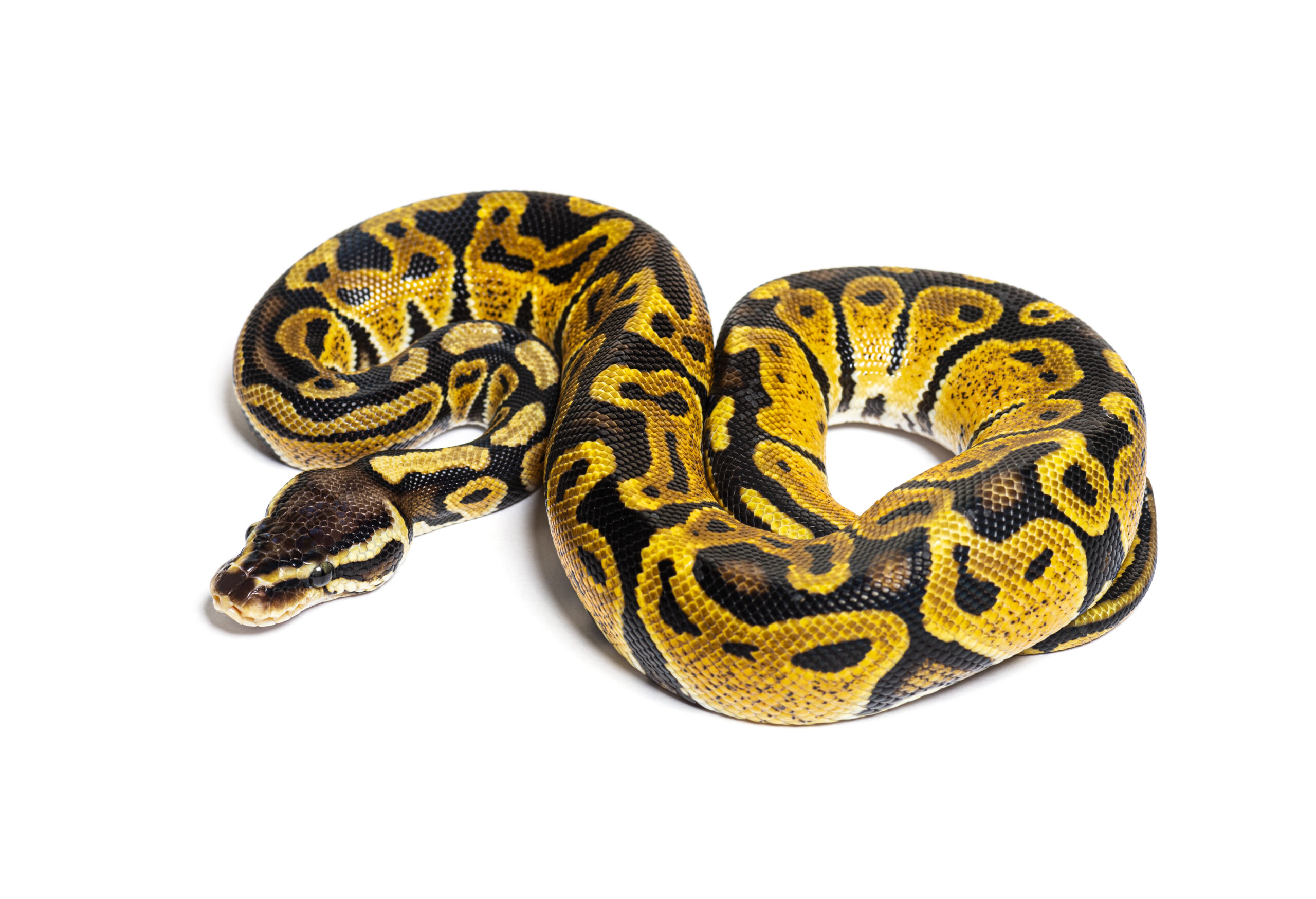If you’ve ever considered bringing a ball python into your home, one of the key factors to consider is its size and growth. These popular pet snakes are known for their manageable dimensions and docile nature, but just how big do they really get? In this blog post, we’ll explore the typical sizes of hatchlings, fully grown adult ball pythons, and the various factors that can impact their growth.
Discover what to expect in terms of size differences between male and female pythons, as well as proper management techniques for ensuring optimal health.
Key Takeaways
- Ball pythons are typically manageable in size, with females measuring between 4-5 feet and males ranging from 2-3 feet.
- Environmental factors such as temperature, humidity levels, and proper nutrition play a significant role in the growth and overall health of ball pythons.
- Female ball pythons generally grow larger than males due to their requirement for additional space necessary during reproduction.
- Regular monitoring of a ball python’s weight, length measurements, skin condition, and consulting with veterinarians regularly is essential for optimal growth rates and long-term wellness.
Understanding Ball Python Size And Growth
Ball pythons are one of the most popular pet snakes due to their manageable size, with females typically measuring between four and five feet in length and males ranging from 2-3 feet.
Typical Size Of Hatchlings
In the early stages of life, Ball Python hatchlings tend to be quite small and delicate creatures. They typically measure around 10 inches in length and may weigh anywhere from 30 to 100 grams, with an average weight of 40 to 60 grams.
For instance, baby Ball Pythons have developed scales that provide them protection from various threats; besides that, they also possess functional heat-sensing pits located under their jaw which allow them to detect warm-bodied prey even in low-visibility conditions like darkness or dense vegetation.
Maximum Size Of Fully Grown Ball Pythons
Fully grown ball pythons in captivity can reach a maximum length of around 6 feet, although this is relatively rare. On average, adult ball pythons typically measure between 2 to 5 feet long.
This manageable size makes them an appealing option for reptile enthusiasts who lack the space or experience necessary to care for larger species of snakes.
It’s important to consider that there are differences in size between male and female ball pythons; females generally grow larger than males. These gender-specific disparities begin to emerge when they are about two years old and continue throughout their lives.
Differences In Size Between Male And Female Pythons
Sexual dimorphism is a characteristic feature in ball pythons, resulting in considerable differences in size between males and females. Female ball pythons generally surpass their male counterparts in terms of both length and weight due to their faster growth rate.
This difference can be attributed to the varied roles played by each gender during reproduction. Females need to accommodate multiple eggs within their bodies, which requires additional space that larger size provides.
Furthermore, this physical distinction assists snake breeders in identifying gender easily during breeding seasons for increased success rates.
Factors Affecting Ball Python Growth
Feeding frequency and diet, environmental conditions, and genetics are all important factors that can affect the growth rate of ball pythons.
Feeding Frequency And Diet
Consistent feeding is essential for Ball Pythons to grow and develop, with proper nutrition being a necessary factor in their growth rate. Hatchlings must be fed more frequently than adult snakes, typically every 5-7 days, as they have faster metabolisms and require more energy.
Adult Ball Pythons can thrive on a 14-day feeding schedule with prey weighing between 5-7% of their total body weight, which may include rats or mice. There are also specialized diets available that cater to the specific nutritional needs of the snakes at different stages of their life cycle.
It’s important to remember not to overfeed your Ball Python as this may lead to obesity-related issues such as respiratory infections.
Environmental Conditions
The environmental conditions in which ball pythons are kept have a significant impact on their growth and overall health. Temperature and humidity levels must be consistently monitored to ensure that the snake is living in an environment that mimics its natural habitat.
If the temperature is too low or there isn’t enough humidity, it can lead to respiratory problems and other health issues for the snake. It’s important to keep temperatures between 78-82 degrees Fahrenheit during the day and about ten degrees lower at night.
In addition to temperature and humidity, proper lighting should also be provided as it helps regulate their internal clock. Natural light exposure during daylight hours coupled with appropriate photoperiods will prevent behavioral disorders like stress or anxiety in ball pythons while ensuring they grow well under optimal conditions.
Genetics
The size and growth of a ball python can also be determined by genetics. In each generation where new combinations are bred together, the genetics become more complex, resulting in a range of color possibilities that are natural due to their genetic diversity.
However, despite proper care, ball pythons do not grow as large as some other types of pythons because size is partially determined by genetics. It’s important to note that there’s no guaranteed way to get your snake to reach its maximum potential genetically.

Proper Management Of Ball Python Growth
Proper management of ball python growth includes maintaining consistent temperature and humidity levels, regularly monitoring their size and weight, and consulting with a veterinarian for any concerns.
Consistent Temperature And Humidity Levels
Maintaining consistent temperature and humidity levels is crucial for the growth and overall health of ball pythons. Here are some important factors to keep in mind:
- Ball pythons require a specific temperature range of around 82-83 degrees Fahrenheit during the day with a slight drop at night for optimal growth.
- In addition to temperature, humidity levels between 50% and 60% are preferred for shedding and overall health.
- Providing hiding places can help maintain these consistent levels by creating microclimates within their enclosure.
- Regularly monitoring temperature and humidity with a digital thermometer and hygrometer can help ensure proper conditions are met.
- Investing in a quality heating system such as under-tank heaters or ceramic heat emitters can help regulate temperature more efficiently.
- Avoid sudden changes in temperature or humidity as this can be stressful on the snake’s system.
By ensuring that your ball python’s environmental conditions are consistent, you’ll be taking an important step towards helping them reach their full potential size and live their best life!
Regular Monitoring Of Size And Weight
Regular monitoring of a ball python’s size and weight is essential for its proper growth and development. Here are some important things to consider when monitoring their progress:
- Weigh your ball python at least once a month using a digital scale that can measure in grams.
- Keep track of the weight and length measurements in a log book for easy reference.
- Note any significant changes in weight or size, as sudden fluctuations could indicate health issues.
- Monitor their feeding schedule and ensure they are eating regularly, but not overfeeding them which can lead to obesity.
- Regularly check their skin for any signs of shedding problems or skin infections.
- Consult with a veterinarian if you notice any abnormal changes in your ball python’s body condition or behavior.
By regularly monitoring your ball python’s size and weight, you can ensure they are growing properly and make adjustments to their care as needed.
Consulting With A Veterinarian For Any Concerns
It is crucial to consult with a veterinarian when it comes to the care and growth of ball pythons. Any health concerns or issues with their growth should be addressed immediately, as they can indicate underlying problems that could potentially shorten the lifespan of your pet.
Furthermore, veterinarians are trained professionals who have experience dealing with the various factors that affect ball python growth, including feeding habits and environmental conditions.
They can help monitor your snake’s size and weight, recommend proper diets and care routines for optimal growth, and provide valuable advice on how to manage any potential health issues that may arise over time.
Conclusion 💭
In conclusion, understanding the size and growth of ball pythons is crucial for proper care and management. While hatchlings typically measure around 10 inches long, fully grown female pythons can reach up to 5 feet in length.
However, factors such as diet, genetics, and environment can affect their growth rate. It’s important to monitor their weight and consult with a veterinarian if there are any concerns.
FAQs:
What is the average size of a fully-grown ball python?
The average size of an adult ball python is between 3 to 5 feet long, but some can grow up to 6 feet in length.
How fast do ball pythons grow?
Ball pythons typically grow about one foot per year during their first three years of life before slowing down over time. Factors such as feeding schedule and environment can affect growth rate.
Are male or female ball pythons bigger in size?
In general, female ball pythons tend to be larger than males due to their need for additional body mass when it comes time for producing eggs.
Can I control the size and growth rate of my ball python through diet and environmental conditions?
While proper diet and living conditions are essential for overall health, a snake’s genetics primarily determines its maximum potential size and growth rate. Providing optimal care does contribute to healthy development, but cannot change what nature has predetermined in terms of ultimate size.




